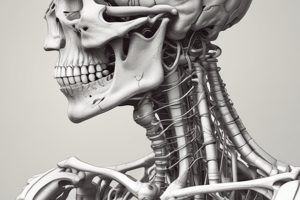Podcast
Questions and Answers
Articulations are places where two bones come together.
Articulations are places where two bones come together.
True (A)
All joints are freely movable.
All joints are freely movable.
False (B)
Joints can only be named according to one of the articulating bones.
Joints can only be named according to one of the articulating bones.
False (B)
Fibrous joints are considered immovable.
Fibrous joints are considered immovable.
The tibiofibular ligament is an example of a synovial joint.
The tibiofibular ligament is an example of a synovial joint.
A ball-and-socket joint allows for multi-directional movement and rotation.
A ball-and-socket joint allows for multi-directional movement and rotation.
Ellipsoid joints have a limited range of motion compared to hinge joints.
Ellipsoid joints have a limited range of motion compared to hinge joints.
Ligaments serve only to connect bones to each other without reinforcing the joint.
Ligaments serve only to connect bones to each other without reinforcing the joint.
A hinge joint allows movement in one direction only.
A hinge joint allows movement in one direction only.
Intracapsular ligaments are located inside the joint capsule.
Intracapsular ligaments are located inside the joint capsule.
Cartilaginous joints are slightly movable.
Cartilaginous joints are slightly movable.
Synovial joints are the least common types of joints in the body.
Synovial joints are the least common types of joints in the body.
Synovial fluid serves to lubricate and reduce friction between moving joint surfaces.
Synovial fluid serves to lubricate and reduce friction between moving joint surfaces.
Meniscus or articular discs are found in all synovial joints.
Meniscus or articular discs are found in all synovial joints.
Synovial fluid helps in nutrient and oxygen distribution to the chondrocytes of articular cartilages.
Synovial fluid helps in nutrient and oxygen distribution to the chondrocytes of articular cartilages.
Flashcards
Types of Joints
Types of Joints
Joints are classified based on their structure and function, such as fibrous (immovable) joints.
Fibrous Joints
Fibrous Joints
Immovable joints, connecting bones with fibrous tissue.
Articulation
Articulation
A point where two bones meet or come together.
Joint Function
Joint Function
Signup and view all the flashcards
Joint Structure and Movement
Joint Structure and Movement
Signup and view all the flashcards
Cartilaginous Joint
Cartilaginous Joint
Signup and view all the flashcards
Synovial Joint
Synovial Joint
Signup and view all the flashcards
Synovial Fluid
Synovial Fluid
Signup and view all the flashcards
Meniscus or Articular Disc
Meniscus or Articular Disc
Signup and view all the flashcards
What are the functions of synovial fluid?
What are the functions of synovial fluid?
Signup and view all the flashcards
Plane Joint
Plane Joint
Signup and view all the flashcards
Saddle Joint
Saddle Joint
Signup and view all the flashcards
Hinge Joint
Hinge Joint
Signup and view all the flashcards
Pivot Joint
Pivot Joint
Signup and view all the flashcards
Ball-and-Socket Joint
Ball-and-Socket Joint
Signup and view all the flashcards
Study Notes
Articulations (Joints)
- Place where two bones come together
- Movement is either freely movable, limited, or no apparent movement
- Structure is related to movement
- Named according to bones/parts united at the joint
- Named according to one of the articulating bones
- Named using Latin equivalent of the common name
- Types of joints are categorized by structure and function
Types of Joints
- Fibrous Joints:
- Immovable (e.g., sutures in the skull, tibiofibular ligament).
- Cartilaginous Joints:
- Slightly movable (e.g., costal cartilage-sternum, pubic symphysis, intervertebral disc).
Synovial Joints
- Most common in the body
- Usually freely movable
- Have articular surfaces on bone with hyaline cartilage
- Completely enclosed joint capsule made of ligamentous connective tissue
- Synovial fluid within the capsule lubricates the joint
- Some have a meniscus or articular disc (e.g., knee, jaw joint)
Functions of Synovial Fluid
- Lubrication: Reduces friction between moving surfaces during compression
- Distribution of nutrients and oxygen to chondrocytes of articular cartilage
- Waste disposal for chondrocytes
- Absorption and distribution of compression forces across articular surfaces outward to the joint capsule
Types of Synovial Joints
- Plane/gliding
- Saddle
- Hinge
- Pivot
- Ball-and-socket
- Ellipsoid
Ligaments
- Strengthen and reinforce joints
- Separate from joint capsule
- Can be intracapsular (inside the capsule) or extracapsular (outside the capsule)
- Example of intracapsular ligaments: cruciate ligaments
- Example of extracapsular ligaments: patellar ligament
Studying That Suits You
Use AI to generate personalized quizzes and flashcards to suit your learning preferences.
Related Documents
Description
Explore the fascinating world of human joints in this quiz on articulations. Understand the types of joints, their structures, and functions, including the crucial role of synovial fluid. Test your knowledge on how these connections enable movement and stability in the human body.



